Autocrafting
The Big One
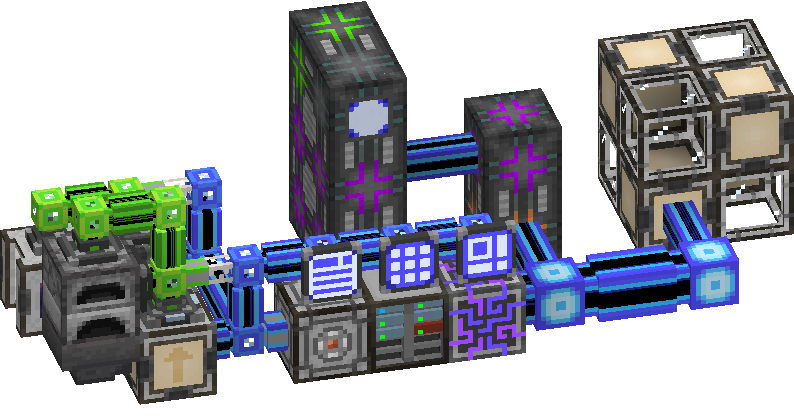
Autocrafting is one of the primary functions of AE2. Instead of manually having to craft the correct number of each sub-ingredient and labor away like some sort of plebian, you can ask your ME system to do it for you. Or automatically craft items and export them somewhere. Or automatically keep certain amounts of items in stock through clever emergent behavior. It also works with fluids, and, if you have certain addons for extra mod material types, like Mekanism gasses, those materials too. It's pretty great.
It is quite a complex topic, so strap in and let's go.
An autocrafting setup consists of 3 things:
- The thing sending the crafting request
- The crafting CPU
- The ME Pattern Provider.
Here is what happens:
- Something creates a crafting request. This can be you in the terminal clicking on something autocraftable, or an export bus or interface with a crafting card requesting one of the item they're set to export/stock.
- (IMPORTANT: use whatever you have bound to "pick block" (usually middle-mouse) to request crafts of something you already have in stock, this can conflict with inventory sorting mods),
-
The ME system calculates the required ingredients and prerequisite crafting steps to fulfill the request, and stores them in the selected crafting CPU
-
The ME Pattern Provider with the relevant pattern pushes the ingredients specified in the pattern to any adjacent inventory. In the case of a crafting table recipe (a "crafting pattern") this will be a Molecular Assembler. In the case of a non-crafting recipe (a "processing pattern") this will be some other block or machine or elaborate redstone-controlled setup.
-
The result of the craft is returned to the system somehow, be it by import bus, interface, or pushing the result back into a pattern provider. Note that an "item entering system" event must occur, you can't just pipe the result into a chest with a ME Storage Bus on it.
-
If that craft is a prerequisite for another craft in the request, the items are stored in that crafting CPU and then used in that craft.
Recursive Recipes

One thing the autocrafting algorithm cannot handle is recursive recipes. For example, duplication recipes like "1 redstone dust = 2 redstone dust", from throwing redstone in a Botania manapool. Another example would be smithing templates in vanilla Minecraft. However, there is a way to handle these recipes.
Patterns
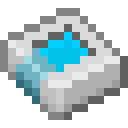
Patterns are made in a ME Pattern Encoding Terminal out of blank patterns.
There are several different types of pattern for different things:
- Crafting Patterns encode recipes made by a crafting table. They can be put directly in a Molecular Assembler to make it craft the result whenever given the ingredients, but their main use is in a ME Pattern Provider next to a molecular assembler. Pattern providers have special behavior in this case, and will send the relevant pattern along with the ingredients to adjacent assemblers. Since assemblers auto-eject the results of crafts to adjacent inventories, an assembler on a pattern provider is all that is needed to automate crafting patterns.
- Smithing Table Patterns are very similar to crafting patterns, but they encode smithing table recipes. They are also automated by a pattern provider and molecular assembler, and function in the exact same way. In fact, crafting, smithing, and stonecutting patterns can be used in the same setup.
- Stonecutting Patterns are very similar to crafting patterns, but they encode stonecutter recipes. They are also automated by a pattern provider and molecular assembler, and function in the exact same way. In fact, crafting, smithing, and stonecutting patterns can be used in the same setup.
- Processing Patterns are where a lot of flexibility in autocrafting comes from. They are the most generalized type, simply saying "if a pattern provider pushes these ingredients to adjacent inventories, the ME system will recieve these items at some point in the near or distant future". They are how you will autocraft with almost any modded machine, or furnaces and the like. Because they are so general in use and do not care what happens between pushing ingredients and receiving the result, you can do some really funky stuff, like inputting the ingredients into an entire complex factory production chain which will sort out stuff, take in other ingredients from infinitely-producing farms, print the entirety of the Bee Movie script, the ME system does not care as long as it gets the result the pattern specifies. In fact, it doesn't even care if the ingredients are in any way related to the result. You could tell it "1 cherry wood planks = 1 nether star" and have your wither farm kill a wither upon receiving a cherry wood planks and it would work.
Multiple ME Pattern Providers with identical patterns are supported and work in parallel. Additionally, you can have a pattern say, for example, 8 cobblestone = 8 stone instead of 1 cobblestone = 1 stone, and the pattern provider will insert 8 cobblestone into your smelting setup every operation instead of one at a time.
The Most General Form of "Pattern"
There is actually an even more "general" form of "pattern" than a processing pattern. A ME Level Emitter with a crafting card can be set to emit a redstone signal in order to craft something. This "pattern" does not define, or even care about ingredients. All it says is "If you emit redstone from this level emitter, the ME system will recieve this item at some point in the near or distant future". This is usually used to activate and deactivate infinite farms which require no input ingredients, or to activate a system that handles recursive recipes (which standard autocafting cannot understand) like, for example, "1 cobblestone = 2 cobblestone" if you have a machine that duplicates cobblestone.
The Crafting CPU
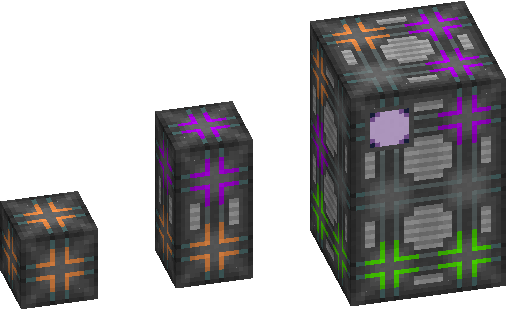
Crafting CPUs manage crafting requests/jobs. They store the intermediate ingredients while crafting jobs with multiple steps are being carried out, and affect how big jobs can be, and to some degree how fast they are completed. They are multiblocks, and must be rectangular prisms with at least 1 crafting storage.
Crafting CPUs are made out of:
- (Required) Crafting storages, available in all the standard cell sizes (1k, 4k, 16k, 64k, 256k). They store the ingredients and intermediate ingredients involved in a craft, so larger or more storages are required for the CPU to handle crafting jobs with more ingredients.
- (Optional) Crafting Co-Processing Units, they make the system send out ingredient batches from pattern providers more often. This allows, say, a pattern provider surrounded by 6 molecular assemblers to send ingredients to (and thus use) all 6 at once instead of just one.
- (Optional) Crafting Monitors, they display the job the CPU is handling at the moment. They can be colored via a Color Applicator - Empty
- (Optional) Crafting Units, they simply fill space in order to make the CPU a rectangular prism.
Each crafting CPU handles 1 request or job, so if you want to request both a calculation processor and 256 smooth stone at once, you need 2 CPU multiblocks.
They can be set to handle requests from players, automation (export busses and interfaces), or both.
Pattern Providers
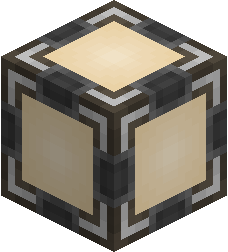
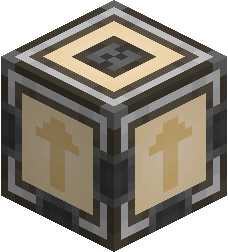
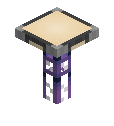
ME Pattern Providers are the primary way in which your autocrafting system interacts with the world. They push the ingredients in their patterns to adjacent inventories, and items can be inserted into them in order to insert them into the network. Often a channel can be saved by piping the output of a machine back into a nearby pattern provider (often the one that pushed the ingredients) instead of using an ME Import Bus to pull the output of the machine into the network.
Of note, since they push the ingredients directly from the crafting storage in a crafting CPU, they never actually contain the ingredients in their inventory, so you cannot pipe out from them. You have to have the provider push to another inventory (like a barrel) then pipe from that.
Also of note, the provider has to push ALL of the ingredients at once, it can't push half-batches. This is useful to exploit.
Pattern providers have a special interaction with interfaces on subnets: if the interface is unmodified (nothing in the request slots) the provider will skip the interface entirely and push directly to that subnet's storage, skipping the interface and not filling it with recipe batches, and more importantly, not inserting the next batch until there's space in storage.
Multiple pattern providers with identical patterns are supported and work in parallel.
Pattern providers will attempt to round-robin their batches to all of their faces, thus using all attached machines in parallel.
Variants
Pattern Providers come in 3 different variants: normal, directional, and flat. This affects which specific sides they push ingredients to, receive items from, and provide a network connection to.
-
Normal pattern providers push ingredients to all sides, receive inputs from all sides, and, like most AE2 machines, act like a cable providing network connection to all sides.
-
Directional pattern providers are made by using a Certus Quartz Wrench on a normal pattern provider to change its direction. They only push ingredients to the selected side, receive inputs from all sides, and specifically don't provide a network connection on the selected side. This allows them to push to AE2 machines without connecting networks, if you want to make a subnetwork.
-
Flat pattern providers are a cable subpart, and so multiple can be placed on the same cable, allowing for compact setups. They act similar to the selected side on a directional pattern provider, providing patterns, receiving inputs, and not providing a network connection on their face.
Pattern providers can be swapped between normal and flat in a crafting grid.
Settings
Pattern providers have a variety of modes:
- Blocking Mode stops the provider from pushing a new batch of ingredients if there are already ingredients in the machine.
- Lock Crafting can lock the provider under various redstone conditions, or until the result of the previous craft is inserted into that specific pattern provider.
- The provider can be shown or hidden on ME Pattern Access Terminals.
Priority
Priorities can be set by clicking the wrench in the top-right of the GUI. In the case of several patterns for the same item, patterns in providers with higher priority will be used over patterns in providers with lower priority, unless the network does not have the ingredients for the higher priority pattern.
Molecular Assemblers

The Molecular Assembler takes items input into it and carries out the operation defined by an adjacent ME Pattern Provider, or the inserted Crafting Pattern, Smithing Table Pattern, or Stonecutting Pattern, then pushes the result to adjacent inventories.
Their main use is next to a ME Pattern Provider. Pattern providers have special behavior in this case, and will send information about the relevant pattern along with the ingredients to adjacent assemblers. Since assemblers auto-eject the results of crafts to adjacent inventories (and thus into the return slots of the pattern provider), an assembler on a pattern provider is all that is needed to automate crafting patterns.
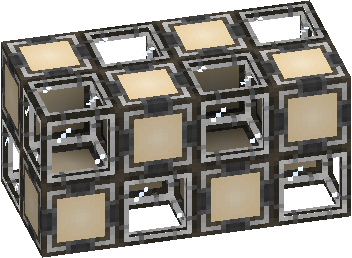
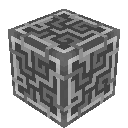 Applied Energistics 2
Applied Energistics 2